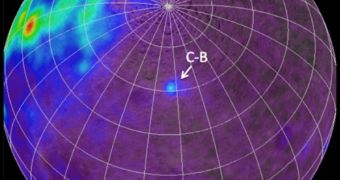Scientists announce the discovery of a volcano on the far side of the Moon, at a location that has been baffling astronomers for several years. The area was known as a curious hot spot, but its position prevented experts from conducting in-depth studies.
The latest images of the structure reveal it to be a volcanic province, a silicic magma upwelling that was formed millions of years ago. The material from which the entire structure is made has a very peculiar chemical composition.
According to investigators, the new datasets will be used to gain a better understanding of the Moon’s thermal history. Ultimately, this could highlight how Earth’s natural satellite formed, and may also provide clues to our planet’s history and origins.
The area where the volcano was found lies between Compton and Belkovich, two very large, ancient impact craters. The structures were first detected back in 1998, by the gamma-ray spectrometer instrument on the Lunar Prospector spacecraft.
What made experts classify this region as a hot spot is the fact that it contains large concentrations of the radioactive chemical element thorium. Officially, the formation isa called the Compton-Belkovich Thorium Anomaly (CBTA).
The latest studies of the area were conducted using the NASA Lunar Reconnaissance Orbiter (LRO), a powerful spacecraft that is capable of conducting different types of analysis in multiple wavelengths. The Diviner instrument was used for this particular research.
With it, experts were able to produce high-resolution 3D models of the terrain. The research team was surprised to learn that the area revealed signs of silicic volcanism, which is very rare.
“To find evidence of this unusual composition located where it is, and appearing to be relatively recent volcanic activity is a fundamentally new result and will make us think again about the Moon’s thermal and volcanic evolution,” says Bradley Jolliff, PhD.
He holds an appointment as a research professor at the Washington University in St. Louis (WUSL) Department of Earth and Planetary Sciences. The scientist is also the leader of the research team that conducted the work.
Details of the investigation appear in the July 24 advance online issue of the top scientific journal Nature Geoscience.
“In the initial LRO images, taken with the orbiter’s Narrow-Angle Cameras (NACs) during the commissioning phase of the mission, we could see lumpy terrain and collapse features that might be volcanic,” the team leader adds.
“To be sure we were seeing volcanic features, we looked more closely, using images from the NACs taken during the mapping phase once the orbiter had reached its 50-kilometer circular orbit,” he adds.
“The NACs [LRO narrow-angle cameras] have telescopic optics and produce images with a 50-centimeter-per-pixel resolution when in a 50-kilometer-altitude orbit. We mapped the same area more than once with the NACs,” he concludes.

 14 DAY TRIAL //
14 DAY TRIAL //